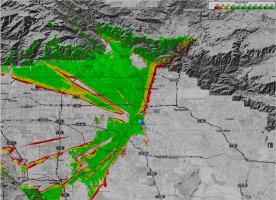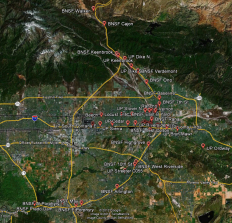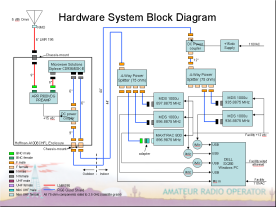
If you find this feed and the coverage it provides useful, and that it adds to your enjoyment of railfanning, consider helping to defray the site's approximately $1200 cost with a donation of $5, $10, $20 or more by clicking on the PayPal "Donate" button above. Donations will go toward server expenses and the potential for new server locations in the Southern California area. Please note that your donations are not tax-deductible. Also note that the donations go to Jon Adams, who acts as treasurer for the funds.
Current Status (04 January 2014)
Site has four receivers operational. UP Ch1 MCP and BCP, BNSF Ch4 MCP and BCP. Originally, we had an additional receiver for Metrolink MCP but subsequently learned that it was quite hard to hear more than 1 or 2 Metrolink MCPs decently from here, so we pulled that receiver for other purposes.
Overview
On 21 July 2012, ATCS Monitor enthusiasts from California and Arizona executed on a plan to establish a new monitoring site for the Inland Empire, and one that would finally give reliable coverage of the historic diamond at Colton CA, where the BNSF San Bernardino Subdivision crosses the UP Yuma Subdivision.
The members of this group included Jon Adams (N7UV), David Curlee (KE6IPY), Ray Eiser (KE6JPV), John Kluender, and Harry Ladd. The planning had been underway for a month or more, stockpiling equipment, making sure that everything needed would be available on the day that everyone met at a generous host's home in Grand Terrace CA.
Finding a Suitable Receive Site
Jon Adams had been interested in monitoring the Inland Empire for years, and in January 2012 started a more detailed search for a suitable site that could provide solid coverage without the ongoing cost of a commercial site. After many cold-call emails and snail mails, most of which were never acknowledged, in May he was able to find a candidate site. The site owner, not a railfan, found our sport sufficiently interesting, just from the technical point of view, that he was willing to offer his home as a potential site.
Modeling Radio Coverage
With any radio receive site, it's important first to have an estimate of what kind of coverage might be expected - it's one thing to eyeball it, but radio waves don't necessarily behave like light. Sometimes better, sometimes worse!
The Radio Mobile coverage model for the Grand Terrace site is conservative, but indicated that the site could be capable of seeing as many as 20 or 30 MCPs. What's never known for sure is exactly the condition of each of those MCPs - what kind of antenna, how much transmitter output, where the antenna might be placed (behind a building or a highway overpass). All these affect the potential reception range. But the model looked good. Google Earth also showed that BNSF control points from the top of Santa Ana Canyon all the way to the base of Cajon Pass, UP CPs from well west of West Colton Yard to around Loma Linda, and Metrolink CPs from Rancho Cucamonga and east were potentially in range.
Building the Site
With a site identified, there were radios to purchase, tune, build up cable harnesses for; there was a low-noise roof-mounted antenna preamplifier that would not only amplify the 900 MHz ATCS wireless signals, but also split them into two bands, one for MCP and the other for BCP; there were many RF, data and network cables to build. The site host provided a 3 GHz Dell SX280 small-form-factor PC running Windows XP Pro SP3, as well as extensive space in one of his closets, the use of his roof for the antenna, internet service and AC power.
John Kluender, well known for his meticulous decoding and attractive, well-organized dispatcher displays, took the new data feed and over the course of a long week tweaked and turned the initial test DD into an excellent tool for monitoring the UP, BNSF and Metrolink lines in range of the new site. But he's not done yet - he continues spend time improving the display, which is available in the files area at the ATCS Monitor Yahoo site.
The site uses a total of five high-quality commercial receivers - four MDS radios, supplied by Jon Adams, receive the MCP and BCP traffic for both the UP and the BNSF.
While the Dell SX280 has a mainboard sound input, it was necessary to add three more sound inputs using the reliable Griffin iMics; two of these were supplied by David Curlee, and one by Ray Eiser.
The antenna is a Larsen 5 dBi gain 890-960 MHz omni at approximately 25' above ground. The two coax runs from the rooftop-mounted antenna preamplifier to the radio room were supplied by Harry Ladd. Harry also gave a generous cash donation to help defray costs.
Once on site, the team discovered the computer didn't have either a keyboard or a mouse - David Curlee drove around town and purchased both, so that Ray Eiser and John Kluender could finish the setup of the server. In under 9 hours, antenna was mounted, coax pulled from rooftop to radio room, computer all configured, closet cleared and reorganized, and shelving installed, and all radios and computer installed and connected. The site was fully functional and providing a volume of data that greatly exceeded expectations.
The data collected from these 4 receivers is piped over the internet directly to a server at Jon Adams' home in Scottsdale, AZ, where it is aggregated with other Southern California feeds (Palmdale, Barstow, Indio, Dana Point) into a single super-feed that is currently generating around 300 packets per minute, and capable of servicing up to 30 simultaneous users. The internet data volume alone is about 1 gigabyte per month, and as the number of aggregated receive sites expands over the next few months, that volume will only increase. The aggregator address and port information are available on the Yahoo site.
Receive Site Technical Details
The hardware system block diagram shows the general layout of the system, from the antenna all the way to the network connection. Significant use of 75 ohm coax and satellite-grade components helped to control cost while not compromising performance. While there is a small impedance mismatch (worst-case about 1.5dB) using 75 ohm coax and components, it is more than made up by the low-noise amplifier atop the roof.
Next, we'll look at the way the data gets from Southern California to Arizona and then to your computer.
Site Cost and Ongoing Expenses
We estimate the equipment cost for this site to be about $800 to $1000, assuming the best deals on eBay. If you add in the costs of driving for the initial setup, realizing that one of the group drove over 300 miles from Scottsdale AZ, spent the day as part of the team setting up the site, and then drove home that night, the gasoline alone expended to get this site up and running was well over $200, making for a total cost to our team of approximately $1200. We did this because it's terrific to see trains easing down or powering up the Cajon, witnessing the challenges the dispatchers face every day dealing with one of the busiest at-grade two-main track crossings in the US while orchestrating the complicated dance that takes place every day moving trains between Southern California and the rest of the US. We also did it for the comraderie and fun. We hope you share our enthusiasm.
The site will continue to require occasional maintenance. While much of the computer maintenance can be done remotely, hardware repair, upgrade and general maintenance requires one of us to be there to get things done. But it's a fun hobby, and we all enjoy participating.
Stay tuned as we add new features in the upcoming weeks and months. We will work to improve coverage by fine-tuning existing sites and adding new ones.
Support Our Efforts by Donating
If you find this feed and the coverage it provides useful, and that it adds to your enjoyment of railfanning, consider helping to defray the site's approximately $1200 cost with a donation of $5, $10, $20 or more by clicking on the PayPal "Donate" button below. We intend the donation process to be transparent and will keep a running total published on this site. If you wish to have your donation acknowledged publicly, add a note when you send it in. Donations will go toward server expenses and the potential for new server locations in the Southern California area. Please note that your donations are not tax-deductible. Also note that the donations will go to Jon Adams, who will act as treasurer for the funds.
Just think of how much gasoline this site can save you by not having to guess where trains may be. Depending on the volume of the donations and our ability to find potential sites, this group may be able to continue to expand coverage through the Cajon and Beaumont Passes, into the Mojave Desert and Coachella and Imperial Valleys. By donating, you will be a valuable part of our effort, and allow us to procure quality, reliable equipment for future sites.
Thanks in advance for your generosity!
Jon Adams N7UV and the group.
jon (at) jonadams (dot) com


